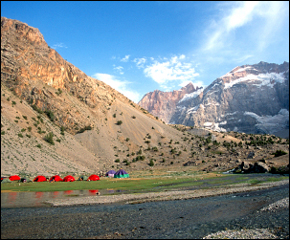Ellen Driscoll’s Plastic Lineage
By Emily Bouckaert
Circle of Blue
Sculptural installation FASTFORWARDFOSSIL: Part 2 uses discarded plastic bottles to comment on global resource and consumption issues.

American artist Ellen Driscoll explores resource consumption and material lineage in her latest multi-part, multi-year project, FASTFORWARDFOSSIL. Driscoll’s second installment of the project, which highlights the relationship between water and oil consumption, was on display last month at the Smack Mellon Gallery in Brooklyn.
“The piece looks back to eighteenth century American industry powered by water, and forward to the oil refineries of the Niger Delta, site of prolonged guerilla warfare against oil corporations and the source of over fifty percent of crude oil for the United States—the oil that produces the plastic within which our privatized water is currently bought and sold, “ Driscoll said.
Her exhibit devours almost the entire gallery floor and is fluttered with mini-mansions of plastic, somewhat Monopoly-esque, that rest on slick, ice-like sheets of plastic. The focal element of the exhibit was the 28-ft long sculptural landscape that depicted North America, the Middle East and Africa floating on a flood of plastic, honeycomb-shaped water molecules. The flood stemmed from the overflowing eighteenth-century water-powered mill. Along the periphery of the exhibit are color-drained drawings of industrial complexes with clusters of black scribbles that depict the “inner workings” of oil refineries.
Each landmass illustrated sites where oil is harvested and subsequently consumed -the same oil that is used in the production of the same easily-discarded plastic bottles used to construct the piece.
Driscoll collected and incorporated 2,600 recycled # 2 plastic bottles, which are made out of polyethylene, the most widely-used plastic. Roughly 80 million metric tons of polyethylene are produced each year with much of the non-biodegradable plastic ending up in landfills and oceans.
She’s been working with the medium since 2007, which spawned into two exhibits, “Phantom Limb” & “Hunter Gatherer,”.
On collecting, or “harvesting” days, Driscoll begins her work 5:30 a.m. in an effort to beat the recycling collection trucks to her discarded treasure. She spends an hour walking through Brooklyn, gathering # 2 plastic milk and water jugs from her neighbor’s recycling bags. She then transports the bottles to her studio where they are cleaned and cut into workable pieces. All told, only a very small waste stream is generated from the “harvesting” process. Driscoll is able to use about 85% of each bottle – the vacuform base of the bottle being the only component she has yet to utilize effectively.
Driscoll displays a strong theme of sustainability throughout all her art and sculpture. Instead of selling her completed sculptures, she dismantles them and incorporates them into her next project, and then recycles all that is left over. The first installment of FASTFORWARDFOSSIL was on display in April.
Using recycled or “poor” materials has been a common thread for almost 20 years. In 1992 she constructed Loophole of Retreat; a large camera obscura constructed of scrap wood and metal that was rescued from dumpsters and constructions sites. Her eyes and hands are instinctively drawn to everyday discarded material. Even as a young child, she was conscious of how even the most mundane and overlooked objects possess a story.
“Every little thing has a story, really nothing is garbage. Every scrap of it has some sort of a lineage that takes you somewhere else.” Driscoll said in an interview with CoB.
Driscoll is the head of the sculpture department at Rhode Island School of design and has been teaching there full-time since 1991. But Driscoll tries not to let her personal approach to sculpture impact the way she teaches her students.
“For better or for worse, I try not to impose my own aesthetic or moral and political passions on my students; I think learning is so much stronger when people come to their own conclusions.”
FASTFORWARDFOSSIL: Part 2 closed in early November, but Driscoll is hoping to find another venue to exhibit the sculpture. She plans to continue the FASTFORWARDFOSSIL project, but has not yet established a timeline. To keep up to date with the future progress of the project, visit the FASTFORWARDFOSSIL Web site.
Check out more on FASTFORWARDFOSSIL here or learn more about artist Ellen Driscoll here.









Leave a Reply
Want to join the discussion?Feel free to contribute!